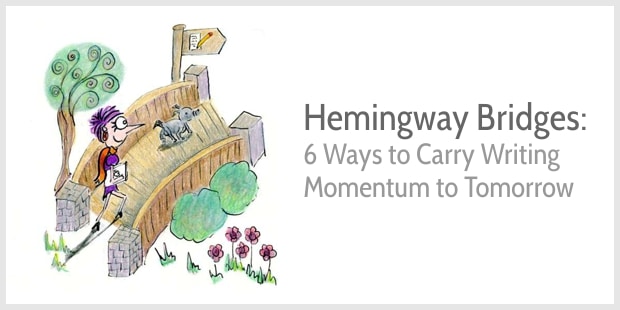 Uhm, yeah …
Uhm, yeah …
The most common writing advice is to write daily.
And it’s sound advice.
But …
Daily writing is not possible for everyone.
It’s never worked for me.
Sometimes I miss a few days; sometimes a few weeks. At best, I write daily-ish.
But I am always (well, almost always) keen to return to writing.
Why?
One thing is that I’ve learned to enjoy writing, even when the writing process is difficult or messy. I love creating something new, and I love sharing my observations with you.
Also, I build bridges.
Hemingway bridges.
A Hemingway bridge keeps momentum going, reduces procrastination, and even helps me write faster. When I’ve built a bridge, I’m eager to get back to writing.
Sound too good to be true?
Let me explain …
What is a Hemingway bridge?
The purpose of a bridge is to make it easier to start writing the next day.
In her book The Creative Habit, Twyla Tharp—a dancer and choreographer—describes the concept as follows:
I stop when there’s still some energy left in the room and I know where we would have gone if we hadn’t stopped. Knowing what comes next is like crocheting: The end of the day knits into the next, and you wind up with a garment that is flexible and strong.
Tharp’s idea of building bridges is based on a quote from Hemingway:
The best way is always to stop when you are going good and when you know what will happen next. If you do that every day when you are writing a novel you will never be stuck. That is the most valuable thing I can tell you so try to remember it.
Building bridges is not just useful for novelists; it works for any creative endeavor. Tharp calls it a creative organizational tool, and she describes a nighttime routine of a writer she knows:
Just before he falls asleep, he reads the last few sentences he wrote. Without fail, he wakes up the next morning brimming with ideas, sentences, whole paragraphs for the next portion of the story. He claims he flies out of bed sometimes so he can get all the words down before they disappear. Apparently, filling up with words and ideas before sleep gives his tired brain some useful work to do as it regroups and refreshes itself overnight.
Our brains continue to process and consolidate ideas, even when we seemingly switch off. Barbara Oakley calls this diffuse-mode thinking. In her book A Mind for Numbers, she suggests a two-step approach to problem solving.
First, do some focused thinking. Next, let go—take a shower, go for a walk, ride your bike, draw, paint, or listen to music without words. Or even better: Sleep on it. Even while asleep, our minds consolidate ideas and make fresh connections.
So, there are two aspects of the Hemingway bridge that make it easier to start writing:
- Manage your energy—leave some drops of energy to make it easier to carry you towards the next day.
- Take breaks—take advantage of diffuse-thinking mode so you can come up with fresh ideas.
Shall we explore?
How I build Hemingway bridges
I build 6 different types of bridges so writing becomes easier.
Plus, the bridges help me write faster and spend less energy on writing.
1. I follow the 90% rule (mostly)
It’s tough to stop before I’m empty.
I like squeezing a little more writing out of a day.
Aren’t we supposed to give it 110%?
In his book Accidental Genius, Mark Levy describes how Robert Kriegel, a mental coach, trains Olympic athletes.
During a practice run he found his sprinters were tense and tight. Rather than asking them to up their efforts, he requested they run the next practice round at 90%.
The result?
Everyone ran faster the second time.
So, I tell myself it’s okay not to give it my all today. I can write at a 90% pace and I can also stop a little early.
Weirdly enough, by going a little slower, I write a little faster.
And by stopping before I’m empty, I can let my enthusiasm carry me towards tomorrow. I’ve built a Hemingway bridge.
2. I write a blog post in 3 to 5 days
The idea for this blog post on Hemingway bridges had been in my mind for a couple of weeks.
One day, I decided to go for it and I jotted down a rough outline.
The next day, I wrote a first draft but not a final paragraph. I changed the headline.
On the 3rd day, I completely re-wrote the opening, changed the headline again, and edited the post. I also wrote a final paragraph. I felt energetic enough to add the post to WordPress.
I then left the post for a few days before a final editing round.
Each blog post is a little different so I don’t follow a strict process. Sometimes, I might edit for 3 consecutive days. Usually, I finish a post the day before publication.
But the basic principle is always to work over multiple days. I let my energy level guide me in how much I write, and I know what I want to work on the next day.
3. I build “non-productive” time into my schedule
I used to think of walking as non-productive time.
But I’ve learned it helps me get more out of the time I’m at my desk.
So, when my back allows, I walk at least once a day.
Walking and sleeping are my favorite productivity tools.
4. I delay difficult work
Whether I’m working on a blog post, a book, or a course, I always write the easiest parts first.
For instance, I find writing an opening paragraph of a blog post tough, so I skip it. I first write the main body of the post, and once that’s done, writing an opening becomes miraculously easier.
But it’s not a miracle. It’s diffuse-mode thinking at work.
5. I assess stuckness
When I feel stuck with something, I just read what I’ve written so far.
Often that already brings up some ideas on how to get unstuck.
But if not, I let go.
I work on something else first, and then return to that difficult part later. It always gets easier over time. Thanks to diffuse-mode thinking.
6. I plan for the next day
Usually, in the afternoon, when I’ve finished work, I write down what I want to work on the next day.
Writing down a plan creates commitment.
It’s also a shutting down ritual: I tell myself I can be satisfied with my work. I give myself a pat on my shoulder.
And I may think I’m finished for the day …
But because I know what to work on tomorrow, my brain keeps thinking about what I’ll write.
And I often wake up feeling inspired.
How to write consistently
Nurturing a daily writing habit is a great goal.
The more regularly you write, the easier it becomes to maintain a habit.
But daily writing isn’t possible for everyone.
So, for me, it’s more important to keep a connection to writing.
Even when I’m not writing on a day, it’s still in the back of my mind what I’ll be writing next.
Building those bridges has been the key to staying productive. I never run out of ideas. I always have a starting point ready for the next post or the next chapter or the next course module.
Happy writing!
More on Hemingway’s writing practices:
How to write like Hemingway
6 inspirational quotes from Hemingway
How to write one true sentence


Great ideas. I will be using them!
Great. Happy writing, Jody!
I feel guilty when I feel it very difficult to get back to writing. But your posts always help me inspire that tiny, messy writer inside me. Although I never used this bridge method for writing (the reason I couldn’t come back after one writing session), I have used it many time for study. When I have to memorize something but it’s not feeding in, I sleep on the idea. My mind keep on processing it and I wake up with the next steps to complete. Later, I learned it is called diffused mode by Barbara Oakley’s coursera course on learning.
I’m going to make these Hemingway’s bridge to get back to my writing. Thank you for sharing! 😄
No need to feel guilty. We all struggle with writing sometimes. Better to be curious. What makes it so hard to get back to writing? How can you make it easier to start again?
Happy writing, Barsha!
I will try that. Thank you, Henneke! 😄
Hello Henneke,
Thank you for sharing your insights on building Hemingway bridges to maintain writing momentum. I’ve always struggled with the pressure of daily writing, and your approach resonates with me. Taking breaks and leaving some energy for the next day sounds like a refreshing way to approach writing.
I loved your tips, especially delaying difficult work and planning for the next day. I’m definitely going to give those a try in my writing routine. It’s great to know that even if we miss a day of writing, we can still stay connected to our writing and keep the ideas flowing.
Your blog is a valuable resource for writers, and I’m grateful for your dedication to creating human-generated content. I agree that AI-generated content can’t replace the personal touch and experience that comes from a human writer.
Looking forward to more inspiring posts from you!
Best regards, S. Mujagic
I’m so glad you found this useful. Happy writing!
I am so glad to see another writer, who writes over a few days. One of the SEO experts I follow call each blog post a “mini business”. It is true.
What is your opinion on AI-generated content? I am trying my best to resist it, and have even advertised it on my Home page, that my content if fully human-generated.
This keeps me accountable to my readers, even if not that many yet.
I truly hope the next best algorithm “figures out” a way to promote human-generated content. Otherwise, it is hard to compete with those bloggers out there, producing 20 posts per week.
AI can do certain writing jobs or part of certain writing tasks but not all. I don’t think AI can write a post like this one—it doesn’t know my personal experience and it can’t quote from books. When we write as humans, we can compete with AI-generated content. You knew it was me writing this, didn’t you?
Hello, Henneke,
This is a great piece of information. Many newbie bloggers are so lazy in creating content. Even in my early days of blogging, I also have the same situation. But gradually hone my writing skills. Practice makes things perfect. Thanks a lot for this helpful post.
Regards,
Vishwajeet Kumar
I don’t think it’s laziness. It’s rarely laziness. More often it’s a lack of habits, a lack of confidence, a lack of direction (being unsure about a blog’s purpose), or a lack of ideas. Perfectionism doesn’t help either.
I do this and I love it.
Only not when I can’t remember, the next morning, what I was sure would be the next thing, tomorrow.
However, it is, even then, my favorite way to write.
I love it, too. It’s a more relaxed way of writing, and it’s much more productive than trying to push myself to do more or to go faster. It makes writing more joyful.
What I find is that if I have a lot of different ideas, I need to write them down, but if I’m working on one or two things, I can trust myself. I won’t forget.
That is probably the main reason I try at least to have a short outline, or part of one, left over–to remind me. That is my best method. I’m sure Hemingway would approve, as long as I didn’t hold him to it. 😉
Yes, making notes is good! I probably should do that more often.
Excellent post, Henneke! You’ve provided lots of great ways to keep that procrastination monkey off my back.
Thank you, Diane. Happy writing!
You convinced me to pack it in today, Henneke. And it’s only 8:24 AM. Stuck and tired from too many grinds.
Excellent. I hope you’ll do something nice and feel reinvigorated tomorrow. Did think a little about what you could work on tomorrow (or the day after)?
I have. I just got off my bike after a sporty 50 minutes riding on local trails with a squeaky front fork, which needs a rebuild. Your magic, plus the noisy fork, provided all the distraction I needed to anticipate Wednesday. It works! Thanks, Henneke.
Yay. That all sounds great … the cycling (apart from the squeaky front fork), the renewed energy, and the anticipation of tomorrow. Happy writing!
I’ve never left a comment before, but I do appreciate you Henneke (and Henrietta). About 40 years ago an English professor told me to end my writing sessions in the middle of a sentence and in the middle of a paragraph if possible. Read that half paragraph before sleep and dream your story . . .
Such an interesting tactic! Have you tried implementing it? I’m asking because it seems so hard to do. I always want to finish at least something.
This is probably some of the best advice I’ve read about writing. For me, once I get going, I don’t ever want to stop until I’m so tired I can’t go on. I know…I know. That not a practical way to stay enthused about writing. After all, who wants to exhaust themselves on purpose. Especially sitting in a chair typing on a computer.
So, thank you for this great advice. It’s something I’ll take to heart and put into practice.
Yes, I know, I know. It’s so hard to stop. I’ve found “stop before empty” a tough practice to implement. Even though, time again, I experience it working, I still sometimes keep going too long.
I hope you’ll enjoy building bridges, Howard. Happy writing!
I love the advice to include “non-productive” time in my working schedule. Taking breaks means a lot to the quality of the work I’m producing but also the labor quality (if you see what I mean?) Pauses are easy to skip, but that often causes more stress than taking time for a walk.
To stop before the energy is exhausted is something I knew but have yet to do. Sometimes deadlines push me to continue, and sometimes it’s the pure enthusiasm of knowing where I’m going with the writing and being curious about how the piece I’m working on will turn out. But I’ll test it out starting today. Thanks for the inspiration, Henneke 🙂
I like your point on taking breaks and how we can produce higher quality work by taking more breaks. I once read some research that we overestimate how long and how well we can keep going. We all probably need to take breaks sooner than we think. It’s one of the reasons I find it useful to work with a timer—it reminds me to take a break.
Thanks so much for stopping by again, Susanna 🙂
Thank you, Henneke. These are really useful strategies for keeping the writing going. As I get older, I find I run out of energy sooner, and these are great ways to pace yourself and get the work done.
Yes, I also run out of energy quickly, making it important to pace myself and use my energy wisely. Thank you for stopping by again!
Thank you for this breakthrough. This has inspired me to continue writing.
Great. Happy writing, Nkwateleng.
Wow! It was some awesome information to have.
I’d be curious to know what was most useful to you. Will you change your writing habits?